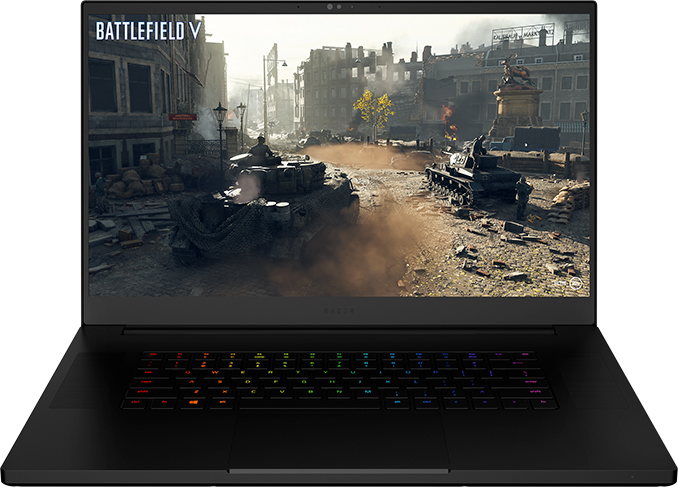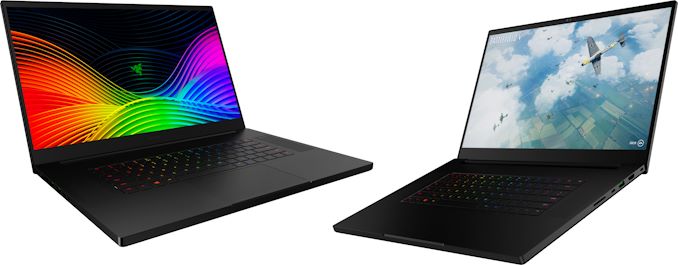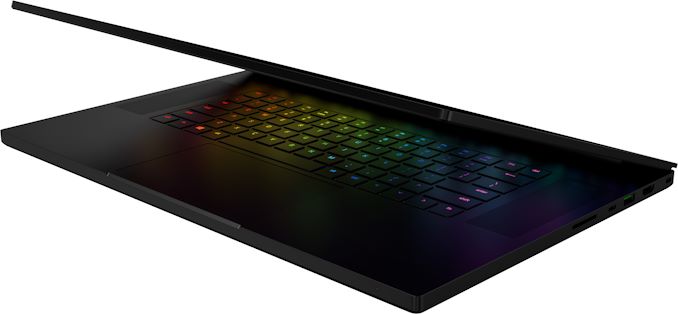Razer Launches the New Blade Pro 17: i7-9750H and RTX 2080 Max-Q
by Anton Shilov on April 24, 2019 12:00 PM EST- Posted in
- Notebooks
- Laptops
- Razer
- Blade
- Razer Blade Pro

Razer has introduced its redesigned Blade Pro 17 laptop aimed at gamers and prosumers that gained performance when compared to its predecessor, yet became considerably more compact and lightweight. The new Blade Pro 17 notebook now packs Intel’s latest six-core Core i7-9750H as well as up to NVIDIA’s GeForce RTX 2080 with Max-Q graphics. Interestingly, the mobile workstation features a UHS-III SD card reader, one of the first in the industry.
17.3-inch laptops are essentially niche products aimed at people who need a combination of high performance and screen size in a clamshell form-factor. Since for the vast majority of end users portability matters, many people prefer high-end 15.6-inch laptops even though it means certain compromises. As a result, to make the 17.3-inch class more popular overall, PC makers attempt to make such machines more compact. This is exactly what Razer tried to do with its new 2019 Blade Pro 17 notebook: the new laptop is 19.9 mm thick and weighs 2.75 kilograms (down from 22.5 mm and 3.07 kilograms in case of the previous-generation model). Overall, it is 25% more compact than its predecessor without any compromises to the screen real estate or rigidity. The new Blade Pro 17 comes in a CNC-machined aluminum chassis as well as features a 17.3-inch IPS display featuring a 1920×1080 resolution, 300 nits brightness, and a 144 Hz refresh rate.
Inside Razer’s Blade Pro 17 there is Intel’s six-core Core i7-9750H processor (2.6 GHz – 4.5 GHz) accompanied by 16 GB of DDR4-2667 memory (expandable to 64 GB of DDR4-3200 memory) as well as a 512 GB PCIe 3.0 x4 SSD (upgradeable to 2 TB) SSD. On the graphics side of things, the machine may be equipped with NVIDIA’s GeForce RTX 2060, RTX 2070 Max-Q, or RTX 2080 Max-Q GPUs.
When it comes to connectivity, the Razer Blade Pro 17 is equipped with Intel’s Wireless-AX200 802.11ax + Bluetooth 5 solution, a 2.5 GbE port, a Thunderbolt 3 connector, three USB 3.2 Gen 2 Type-A ports, one USB 3.2 Gen 2 Type-C port, an HDMI 2.0b output, a UHS-III SD card reader, a 3.5mm audio jack, and so on. In addition, the system has a 1MP/720p webcam with IR sensors for Windows Hello, an array microphone, and Dolby Atmos-supporting stereo speakers.
As for battery, the Razer Blade Pro 17 is equipped with a 70.5 Wh battery pack. Given the number of configurations that Razer plans to offer, the manufacturer does not disclose battery life of each one.
| The Razer Blade Pro 17 General Specifications | |||||||
| RZ09-02876*92 | RZ09-02877*92 | RZ09-02878*92 | |||||
| Display | Diagonal | 17.3" | |||||
| Resolution | 1920×1080 | ||||||
| Response Time | ? ms | ||||||
| Brightness | 300 cd/m² | ||||||
| Refresh Rate | 144 Hz | ||||||
| Color Gamut | sRGB: 100% | ||||||
| CPU | Intel Core i7-9750H processor: 6C/12T, 2.6 GHz Base 4.5 GHz Turbo 12 MB |
||||||
| RAM | 16 GB DDR4-2667 Upgradeable to 64 GB DDR4-3200 |
||||||
| Graphics | RTX 2060 6 GB GDDR6 |
RTX 2070 8 GB GDDR6 |
RTX 2080 8 GB GDDR6 |
||||
| Storage | 512 GB - 2 TB PCIe 3.0 x4 SSDs Spare M.2 slot for PCIe or SATA SSDs |
||||||
| Wi-Fi | 2×2 802.11ax Wi-Fi module | ||||||
| Bluetooth | BT 5.0 | ||||||
| General Ports | 1 × Thunderbolt 3 for data, display output 1 × USB 3.12Gen 2 Type-C 3 × USB 3.2 Gen 2 Type-A 1 × HDMI 2.0b 1 × 2.5 GbE |
||||||
| Other I/O | HD webcam with IR, TRRS connector for audio, speakers, microphone array, SD UHS-III card reader |
||||||
| Dimensions (W × D × H) | 395 × 260 × 19.9 mm 15.55 × 10.24 × 0.78 inches |
||||||
| Weight | 2.75 kg | 6.06 pounds | ||||||
| Battery | 70 Wh | ||||||
| Price | $2,499 | $2,799 | $3,199 | ||||
Razer will start sales of its new Blade Pro 17 sometimes in May from its own stores and select retailers the United States, Canada, United Kingdom, France, Germany, and China. Prices will start at $2,499 in the US and €2,699 in Europe.
We hope to see a version of the new Blade Pro 17 with an Ultra-HD DCI-P3-supporting screen.One of the things that strikes the eye about the Blade Pro 17 is its integrated UHS-III SD card reader that is needed primarily by professional photographers that plan to use next-gen cameras.
Related Reading
- Razer Launches The Razer Blade 15.6
- Razer Reveals New Blade Pro: GTX 1060 Graphics, Full HD, Lower Price Point
- Razer Updates The Razer Blade Pro With THX Certification
Source: Razer













22 Comments
View All Comments
willis936 - Wednesday, April 24, 2019 - link
1080p on a 15" screen is one thing...It's surprising how some razer laptops can be amazingly good while others are amazingly bad. The price should at least reflect as much. I feel bad for anyone buying this model.
bunnyfubbles - Wednesday, April 24, 2019 - link
You must have missed the 144Hz part, the 4K fad for the sake of having 4k is done (we'll eventually get there, but it isn't necessary until all the parts are capable and affordable), people are wising up to the superiority of motion clarity. This is a much better option for gaming than having a 4K 60Hz screen, or a far more expensive 4K 120+Hz solution.willis936 - Thursday, April 25, 2019 - link
I didn't miss the 144 Hz part. A large, expensive gaming laptop should be going to 1440p120. That's been the standard for high end gaming for the past four years.KateH - Wednesday, April 24, 2019 - link
now thats a gorgeous - and handsomely specc'd- machine.wish it had a 4K/60 display option and didn't omit the numpad (tho i can see why they didn't include one)
oh, and while i'm making wishes- I wish i could afford one! ;)
KateH - Wednesday, April 24, 2019 - link
holy crap, i looked up what the clocks are on the Max-Q 2080- Digitaltrends quotes 735Mhz base, and 1095Mhz boost. That's rough even by Max-Q standards.DejayC - Thursday, April 25, 2019 - link
The 15in has the option for a 4K display... why doesn’t the bigger laptop have that option? At least have 1440p.Ckyannanta - Monday, April 29, 2019 - link
Have you ever seen so many sexy girls in one place? Theyre right here: http://datinghookupmeet.cf/ckyannantaFXi - Tuesday, April 30, 2019 - link
They're not cookin' with gas until we get 9850 and 9880, not the HK ones however. And this very model begs the question again, why SDC didn't market a 17.3" OLED panel to go alongside the 15.6, 14 and 13.3. An OLED panel on here would have nailed it really.s.yu - Tuesday, April 30, 2019 - link
I don't get the specs. Nothing I see here compels me to consider the 17" over the 15" except the card reader. Even if they had a 32GB version, I could consider that, because I wouldn't have to spend extra to upgrade myself, OTOH there's no wide gamut panel, the battery's smaller, and I don't see a mercury white version. I really don't get this, unless the 2080 is 30% faster sustained than on the 15" maybe that'll make it worth while.